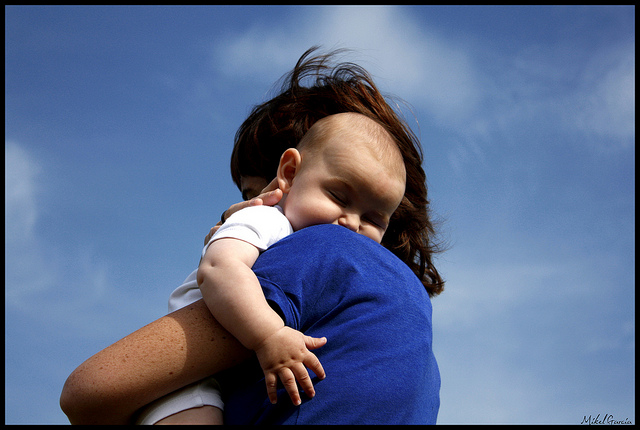Like this article? rabble is reader-supported journalism. Chip in to keep stories like these coming.
Lindsey McKay, postdoctoral fellow at Brock University’s Sociology Department, is among the thousands of Canadian mothers ineligible for maternity benefits.
McKay, who gave birth to twins in 2011, missed out because she was studying at the time.
According to requirements under the Employment Insurance (EI) system, McKay was ineligible for payments because she had not accumulated at least 600 hours’ work in the 12 months prior to her twins’ births.
“I worked for about a decade [and was contributing to EI], and then I returned to school, so my children were born in a period in which I wasn’t working full time,” says McKay, who is also a research associate at Brock University’s Social Justice Research Institute.
“Three years after the birth, I’m working full time again, and contributing again.
“I think I should be included in the people who are covered by this program, as should be all kinds of mothers.”
McKay teamed up with her colleagues Andrea Doucet, Brock University professor of Sociology and Women’s and Gender Studies, and Sophie Mathieu, Universite de Montreal Sociology Department lecturer, to investigate how income levels impact on access to maternity and parental leave benefits under EI and the Quebec Parental Insurance Plan (QPIP).
Based on 2013 data from Statistics Canada, the trio’s analysis found mothers living in lower income households were not accessing maternity benefits as much as their counterparts in higher income brackets. The disparity between income groups was particularly severe under EI, with Quebec’s system achieving more regular benefit coverage between income groups. Mothers living in the three territories were not accounted for in the Statistics Canada figures.
Canada’s poorest mothers are worse-off
According to the data, 85.4 per cent of mothers from homes earning less than $30,000 annually received maternity benefits in Quebec, compared to just 43.6 per cent in the nine provinces. For mothers in the next household income bracket ($30,000 to $60,000), about 90 per cent received maternity benefits in Quebec, compared to about 69 per cent under EI. At the top end of the spectrum ($60,000 plus), 95 per cent of mothers got benefits in Quebec, compared to 74 per cent in the other provinces.
Overall, nearly 90 per cent of mothers living in Quebec received maternity benefits, compared to about 64 per cent of mothers in the nine provinces.
McKay blames the significant disparity between Quebec and the rest of Canada on the tough eligibility requirements under EI, as well as the system’s comparatively conservative benefit payments.
In Quebec, residents must have earned at least $2,000 in the previous tax year to qualify for maternity and paternal benefits. At minimum wage, that’s 190 hours work. In the rest of Canada, 600 hours of work is required in the year up to the birth to qualify for parental and maternity benefits.
Mothers can also receive up to 70 per cent of their wage for 18 weeks under the QPIP maternity benefit, compared to 55 per cent wage replacement over 15 weeks under EI. The overall parental benefit package is also better in Quebec, McKay says.
“We think it’s [EI] a great program — why not help more people access this program, either through lowering the eligibility criteria to match Quebec or by creating some fund for those who aren’t eligible,” McKay says.
Addressing the lack of affordable childcare outside of Quebec is also essential to achieving better benefit coverage.
“Some of the mothers who are excluded outside of Quebec may also be mothers who are from families where they cannot afford childcare. They decide that the lower earner, which is often the woman, will stay home and care for the first child. And then she’s ineligible for parental leave for the second child.”
Parental leave and child-care affordability is interlinked and mothers and fathers need a genuine choice about how to have their children cared for.
A numbers game
Improving research and analysis on mothers and young families, and their interactions with EI and other benefit programs is also important.
Identifying which mothers and families are missing out on maternity and parental benefits, how this relates to the program’s eligibility criteria and the influence of things like child-care costs on access needs to be properly analysed, McKay says.
Any changes to the system, including those being proposed by the Liberal government, must account for all these factors.
“The pattern has been here that there’s been an extension of duration and of types of caregivers [in EI], however none of that addresses the issues of who can actually access this.”
“What our analysis shows, is that there’s a disproportionate benefit for higher earners in this program — every other welfare program redistributes universally, or redistributes to families who really need it at the lower end of the socio-economic spectrum.”
Changing parental leave — extending it in particular — is unlikely to benefit those who need it most if childcare is also not addressed, McKay says.
Read all of Teuila Fuatai’s special series on employment insurance here.
Teuila Fuatai is a recent transplant to Canada from Auckland, New Zealand. She settled in Toronto in September following a five-month travel stint around the United States. In New Zealand, she worked as a general news reporter for the New Zealand Herald and APNZ News Service for four years after studying accounting, communication and politics at the University of Otago. As a student, she had her own radio show on the local university station and wrote for the student magazine. She is rabble’s labour beat reporter this year.
Photo: flickr/Mikel Garcia Idiakez



